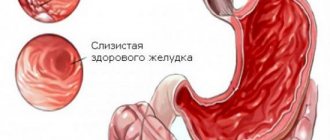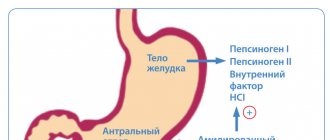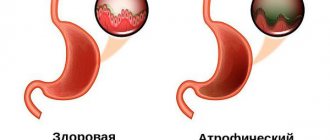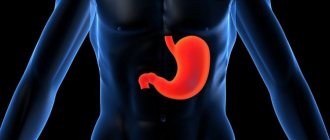What is chronic gastritis?
Chronic gastritis is a disease characterized by a chronic inflammatory process of the gastric mucosa with impaired regeneration, a decrease in the number of glandular cells, and, as it progresses, with atrophy of the glandular epithelium with the subsequent development of intestinal metaplasia and dysplasia, a disorder of the secretory, motor and often endocrine functions of the stomach. Gastritis is based on dysregeneration. 80% of the population suffers from chronic gastritis. The group of diseases diagnosed as “ chronic gastritis ” includes several of its variants, significantly different in etiology and pathogenesis. A synonym for gastritis is inflammation of the stomach, inflammation of the gastric mucosa, inflammation of the gastric mucosa .
Prevention
Prevention of chronic gastritis involves preventing factors that can cause damage to the mucous membrane. These are hygienic measures against Helicobacter infection: thoroughly washing dishes, using each family member’s own cups, plates and cutlery. Care must be taken when handling medications and chemicals that are potentially harmful to the health of the digestive system.
If you do get gastritis, it is important to take timely measures to prevent it from becoming chronic. The main goal of prevention in this case is to maintain a favorable microbiome (microflora) of the digestive tract.
To prevent the development of the disease you should:
- eat often in small portions;
- avoid foods that may irritate the stomach;
- reduce or eliminate alcohol consumption;
- quit smoking;
- avoid stress.
Factors of ulcerogenesis (ulcer formation)
The main factors of ulcerogenesis (ulcer formation factors) caused by Helicobacter pylori infection are:
1) persistent increase in acid production;
2) violation of motor-evacuation function;
3) polymorphonuclear infiltration of the gastric mucosa, causing damage to epithelial cells;
4) the development of local immune, inflammatory and biochemical reactions in which Helicobacter pylori (HP) takes part;
5) damage to the endothelium of the gastric microvessels, which disrupts microcirculation and trophism of the mucous membrane;
6) qualitative and quantitative changes in mucus, a decrease in its hydrophobicity, a decrease in viscosity, a decrease in the thickness of the mucus layer, an increase in the content of oxygen metabolites, an increase in reverse diffusion of H+ in the gastric mucosa;
7) slower healing of erosions and ulcers of the gastroduodenal mucosa.
Drinks and hydration
At the first signs of gastritis, you need to refuse food for the first day.
At the first signs of gastritis, it is better not to eat anything for the first day. But it would be wrong to limit the drinking of a patient with gastritis.
It is recommended to drink water or still mineral water. Chilled, weak tea is also suitable. Subsequently, in case of increased acidity, you need to drink water 15-20 minutes before eating.
It is impossible to manage a dietary diet without dairy products. One of the valuable drinks is kefir, which contains amino acids and trace elements.
Lactose, which has a beneficial effect on the digestive system and nervous system, and a low milk fat content, make kefir a drink recommended for consumption before bed or during dinner.
For gastritis, it is better to drink milk, especially homemade milk, in a diluted form; it is better to add it to tea. The undoubted benefit and first place among dairy products useful for gastritis is goat's milk. It is recommended to neutralize too much hydrochloric acid, to heal defects in the mucous membrane, and against gastritis symptoms such as bloating or flatulence.
Hypertrophic gastropathy, Ménétrier's disease, Zollenger-Ellison syndrome
These include Menetrier's disease (giant hypertrophic gastritis) , Zollinger-Ellison syndrome and mixed hyperplastic gastropathy.
Currently, we do not recommend using the classification of RG Strickland and JR Mackay (1973), which distinguished chronic gastritis A and B. Specialists at our clinic recommend using the Sydney (international) classification of chronic gastritis.
It is based on endoscopic and microscopic (histological) criteria.
Nutrition for gastritis with low acidity
Fermented milk products are perfect for gastritis with low acidity.
With this type of gastritis, food is not completely digested because there are not enough digestive enzymes and insufficient hydrochloric acid is produced.
Products on such a diet should stimulate the production of gastric juice. The food receptors that trigger this mechanism are affected by the following foods and dishes:
- strong and rich broths and soups,
- sweet and sour fruits, citrus fruits,
- pickles and pickled vegetables,
- fermented milk drinks (kumys, ayran, kefir),
- sour fruit juices,
- sour non-carbonated mineral waters.
To stimulate the release of enzymes, chew food thoroughly.
Gastritis, classification, Sydney system, 9th International Congress of Gastroenterologists
In August 1990, in Sydney, Australia, at the 9th International Congress of Gastroenterologists, a new classification of gastritis , called the “Sydney system” (JJ Misiewicz, GNJ Tytgat, P. Sipponen, AB Price, CS Goodwin, RG Strickland). The histological basis of classification consists of three parts: etiology, topography and morphology.
Etiology : Helicobacter pylori (HP) associated gastritis, autoimmune gastritis, idiopathic gastritis, acute drug-induced gastritis, special forms of gastritis (reactive, eosinophilic, lymphocytic, granulomatous, collagenous, lymphoblastic). Hypertrophic gastropathy.
Morphology : tied to the section of the stomach - topography (fundic, antral, pangastritis). Based on the histological picture, the degree of inflammation, activity, atrophy, intestinal metaplasia and Helicobacter pylori contamination is assessed as: absent, mild, moderate, severe. Without assessing the degree, specific and nonspecific changes are distinguished.
The endoscopic section involves indicating the topography of pathological changes (antral, fundal, pangastritis). Manifestations of pathology (edema, erythema, swelling, aphthae, erosion, nodularity, hyperplasia, atrophy, vascular reaction, hemorrhage) are also assessed. The following categories are proposed as a diagnosis for endoscopists: erythematous, exudative, erosive, atrophic, hemorrhagic, reflux gastritis, fold hyperplasia.
Hypertrophic gastropathy (giant hypertrophic gastritis, Menetrier gastritis) is distinguished separately according to the Sydney classification.
Symptoms of chronic gastritis
What are the main symptoms and signs of gastritis? The clinical picture of chronic gastritis is nonspecific and is determined by the presence of dyspepsia associated with gastritis. According to our data, 46% of patients with chronic gastritis have dyspeptic complaints. Sometimes there is an asymptomatic course of chronic gastritis.
Chronic Helicobacter gastritis
Chronic Helicobacter gastritis can be asymptomatic, which is observed in 52% of cases. There is no connection between the development of an infectious exacerbation and the appearance of any clinical symptoms.
Chronic Helicobacter antral gastritis with increased acid production is often associated with an ulcer-like variant of dyspepsia. This form of gastritis is subjectively manifested by pain, heartburn, sour belching, nausea, and a tendency to constipation. Pain occurs 1.5 - 2 hours after eating, and sometimes after a longer period of time (late pain). Appetite is usually not impaired. Objectively, pain is detected on palpation in the epigastric region, more on the right. As Helicobacter pylori gastritis progresses, pangastritis and atrophic gastritis develop, which causes a change in the clinical picture.
Atrophic gastritis
Atrophic gastritis often manifests itself as a dysmotor variant of dyspepsia. Patients complain of a feeling of heaviness, fullness in the epigastric region, rapid saturation, belching of air, or, if the process is severe, rotten. Nausea is common. Sometimes there is dull pain in the epigastrium. The pain intensifies after eating. Rough food is poorly tolerated. Appetite is often reduced. An unpleasant, often metallic taste in the mouth is possible. Objectively, a tongue coated with a white coating and diffuse pain on palpation in the epigastrium are detected.
Autoimmune atrophic gastritis
Autoimmune atrophic gastritis . With autoimmune atrophic gastritis , accompanied by B 12-deficient anemia, the clinical picture of atrophic gastritis described above is supplemented by signs of anemic syndrome, which is characterized by weakness, dizziness, astheno-neurotic syndrome, pain in the heart region like ischemic and cardialgia, pallor of the skin and mucous membranes , subicteric sclera, “lacquered” tongue, moderate enlargement of the liver, systolic murmur on auscultation of the heart.
Often, any gastroenterological pathology eventually leads to combined damage to the digestive system. In severe cases of chronic atrophic gastritis, malabsorption syndrome develops.
Chemical gastritis
Chemical gastritis often manifests itself with symptoms of dysmotor dyspepsia. With reflux gastritis, dull pain in the epigastric region occurs during or immediately after eating, a feeling of bitterness and dry mouth, belching, nausea, and loss of appetite. With reflux gastritis of the gastric stump, manifestations of dumping syndrome come to the fore in the clinical picture.
Radiation gastritis
Radiation gastritis. The clinical picture of radiation gastritis is determined by the dose of radioactive radiation. With a mild degree of radiation sickness (1 - 2 Gy), changes in the gastric mucosa are insignificant, with an extremely severe degree (6 - 10 Gy), extensive coagulation necrosis occurs with the formation of ulcers and secondary inflammatory infiltration.
Granulomatous gastritis
Granulomatous gastritis. The clinical picture of granulomatous gastritis is dominated by manifestations of the underlying disease (Crohn's disease, sarcoidosis). The symptoms of this type of gastritis are nonspecific; there are symptoms of dyspepsia. When the granuloma is localized in the pylorus, vomiting is possible; with slit-like ulcers in the area of granulomatous lesions, vomiting can be bloody.
Lymphocytic gastritis
Lymphocytic gastritis is usually asymptomatic or occurs with the usual clinical picture of dyspepsia.
Eosinophilic gastritis
Eosinophilic gastritis. There are no specific manifestations of eosinophilic gastritis. With systemic scleroderma, polymyositis and dermatomyositis in patients with eosinophilic gastritis, there is no eosinophilia in the peripheral blood.
Infectious gastritis
Infectious gastritis. The picture of infectious gastritis is largely determined by the etiology of the pathogen.
Collagenous gastritis
Collagenous gastritis has no clinical manifestations.
Ménétrier's disease
Menetrier's disease. What are the main symptoms of Ménétrier's disease? With Ménétrier's disease, patients complain of pain in the epigastric region that occurs after eating, manifestations of dysmotor dyspeptic syndrome, and heartburn. Vomiting is possible, sometimes mixed with blood. Appetite is reduced, weakness and sometimes diarrhea are noted. Objectively, a decrease in body weight, hypoproteinemic edema in the feet and hands, iron deficiency anemia, and hypoalbuminemia are observed (albumin is released into the lumen of the stomach).
Treatment
Treatment is always selected individually depending on the type of gastritis and its cause. Timely treatment can reduce symptoms, if present, and reduce the likelihood of complications.
Medicines
Drug treatment of chronic gastritis can be symptomatic or etiological - aimed at eliminating one or another cause of the disease. If H. pylori is detected in a patient with gastritis, eradication therapy is used to destroy it. In particular, the “French method” is popular today, which involves a combination of three drugs - two antibiotics plus a proton pump inhibitor. Unfortunately, it is impossible to eliminate the infection forever; after some time, the harmful microorganism again enters the body from carriers, in particular, from the patient’s relatives. Helicobacter very quickly becomes resistant to drugs, so the same antibiotics cannot be prescribed all the time.
With chemical gastritis, it is enough to eliminate its cause. For example, stopping taking medications whose side effects caused the disease. If it is not possible to refuse such a medicine, measures are taken to protect the stomach with the help of coating agents and drugs that regulate the acidity of gastric juice. The use of antacid (anti-acid) drugs helps restore damaged mucosa. It must be remembered that with the disappearance of the acid, its powerful antibacterial function disappears.
The selection of therapy for autoimmune chronic gastritis depends on the severity of inflammation. Basically, the use of medications is aimed at reducing the acidity of gastric juice. These are proton pump inhibitors, antacids and antihistamines.
Nutrition
Chronic gastritis cannot be overcome with medications alone. Radical changes are required in the patient's lifestyle, diet and diet. Therefore, already at the first appointment, the gastroenterologist necessarily recommends a certain type of diet depending on the acidity of the gastric juice: if it is low, you need acidic (berries, fruits) and juice products, if it is high, you need those that reduce the production of hydrochloric acid.
Let us highlight products that are incompatible with the treatment of gastritis and are strictly contraindicated:
- Spices and seasonings, especially hot ones.
- Fat meat.
- Any fried food.
- Smoked and canned products.
- Concentrated fruit and berry juices, especially those with a high content of acids and sugars.
- Carbonated drinks.
Important ! It is recommended to limit the consumption of confectionery products (never eat them on an empty stomach!), rye bread, fresh wheat pastries, strong tea and coffee.
There are quite a few approved foods for gastritis. By consuming them, you can easily create a varied and complete diet. Patients with gastritis are shown:
- Dairy products.
- Stale yeast bread.
- Lean meat, fish, soft and semi-hard cheeses.
- Soft-boiled eggs and omelet.
- Boiled cereals.
- Puree soups.
- Boiled and baked vegetables, fruits.
Diet for patients with chronic gastritis
Photo: natabuena / freepik.com
A diet for chronic gastritis is aimed at developing favorable microflora in the gastrointestinal tract that regulates digestion and has a protective function. Meals should be fractional: regular meals 5-6 times a day. You should choose dishes that are boiled or steamed. Preferably boiled or baked meat, fermented milk products, high-fiber cereals, boiled or baked vegetables (Table 2).
The main amount of food should be consumed in the first half of the day.
It is necessary to avoid “snacks” of high-calorie foods and eating sweets on an empty stomach. Table 2. Dietary recommendations for patients with chronic gastritis
| Gastritis with low acidity | Gastritis with high acidity |
| Healthy | |
| lean meat, fish, poultry; boiled, chopped, baked or lightly fried without breading in breadcrumbs or flour | whole milk (reduces the production of gastric juice) after meals. If the patient does not tolerate it well, you can add milk to tea |
| soups: meat, fish, mushroom, vegetable, cereal | cream, low-sour cottage cheese |
| whole milk only in dishes and drinks (porridge, cocoa), fermented milk products, cottage cheese, soft-boiled eggs, omelet | boiled, stewed, baked vegetables |
| well-cooked porridge, boiled pasta | all porridges, except millet, pasta |
| toasted white bread | lean meat, lean fish and poultry |
| non-acidic varieties of apples, pears, bananas | |
| white bread, preferably not too soft | |
| Provokes exacerbation | |
| spicy, salty, fried foods | juice products |
| canned meat and fish | strong and fatty broths - meat, fish and especially mushroom |
| soft bread and other fresh products made from yeast dough, baked goods | raw vegetables, pickles, marinades, spicy vegetable snacks, smoked meats |
| pastry, pies, brown bread | |
| ice cream, cold drinks | |
| sour juices, black bread | |
Aids
The most recommended home remedy to alleviate the disease is a decoction of chamomile. Among plants exotic to our nature, aloe juice is used as a strong anti-inflammatory agent. Oat infusion is also useful for chronic gastritis, helping to restore the affected mucous membrane. Of course, traditional methods of treatment cannot replace qualified medical care and therapy.
Gastritis in children
Children usually get gastritis at school age due to irregular and irrational nutrition; there is even a diagnosis - “school gastritis”. Treatment in this case is aimed not only at getting rid of the disease, but also at developing healthy eating habits.
Gastritis and pregnancy
Difficulties in treating gastritis in pregnant women are associated with the possible effects of the medications used on the fetus. When selecting therapy, you have to weigh the possible benefits of the medication and the harm it can cause. This primarily concerns antibiotics, many of which are strictly contraindicated during pregnancy. Proton pump inhibitors are harmful during pregnancy.
Histological signs of Helicobacter pylori gastritis
The main histological signs of Helicobacter gastritis are:
1) pronounced neutrophil infiltration in the pit epithelium with cell damage;
2) lymphocytic and plasmacytic infiltration of the lamina propria;
3) lymphoid follicles;
4) the presence of Helicobacter pylori (usually with non-atrophic gastritis).
Additional histological signs of Helicobacter gastritis are:
1) intestinal epithelial metaplasia;
2) atrophic changes;
3) dysplasia;
4) ulceration of the gastric mucosa.
Diagnostics
Gastritis is much easier to treat if it can be diagnosed in the early stages of the disease.
Who to contact
Gastroenterologists, doctors specializing in diseases of the digestive system, are responsible for the diagnosis and treatment of chronic gastritis. Gastritis often becomes an accidental finding during a routine examination or search for other diseases. Gastroenterology is a broad branch of medicine that requires the doctor not only highly specialized training, but also interdisciplinary knowledge and good erudition.
What tests should I take?
The classic method for diagnosing gastritis is gastroscopy (esophagogastroduodenoscopy, endoscopy), which is combined with a biopsy if a malignant process is suspected. During the procedure, a special device is inserted into the patient’s stomach through the mouth - a gastroscope, consisting of a long tube with a built-in camera. It allows the endoscopist to examine in detail the condition of the mucous membrane of the esophagus, stomach and duodenum (Fig. 2).
Figure 2. Performing gastroscopy. Photo: CC0 Public Domain
Since most cases of CG are associated with the presence of the bacterium Helicobacter pylori in the body, when gastritis is detected, a urease breath test is often performed (for the enzyme urease secreted by Helicobacter), as well as a blood test for antibodies to this bacterium or a stool test for the presence of its antigens in it.
Computed tomography and magnetic resonance imaging help answer the question: is it really gastritis and does the patient have stomach cancer (Fig. 3).
Figure 3. Gastritis detected on tomography. Photo: Eigenes Werk
Eradication (removal) of Helicobacter pylori HP is the basis for the treatment of chronic gastritis
Complex differentiated treatment of patients with chronic gastritis with the widespread use of new reflexotherapeutic proprietary techniques in our clinic allows us to achieve satisfactory results even with a pronounced clinical picture of the disease, and to eradicate Helicobacter pylori. Eradication of Helicobacter pylori cures chronic non-atrophic Helicobacter gastritis. The repair of gastroduodenal ulcers is accelerated, acid production in the stomach is normalized, the vicious chain is broken: Helicobacter pylori infection - inflammation - atrophy - metaplasia - dysplasia - cancer !
Sign up for a consultation. There are contraindications. Specialist consultation is required.
Photo: Benjaminthorn | Dreamstime.com\Dreamstock.ru. The people depicted in the photo are models, do not suffer from the diseases described and/or all similarities are excluded.
Related posts:
Reflux esophagitis: symptoms, treatment, gerb, gastroesophageal reflux disease
Belching, treatment, frequent rotten belching of air, eggs, food
Stomach ulcer, duodenal ulcer, peptic ulcer: treatment in Saratov
Heartburn, burning in the stomach, treatment in Saratov, how to get rid of heartburn, what to do
Hepatomegaly, steatosis, fibrosis, alcoholic hepatitis, liver cirrhosis, alcohol damage
Comments ()
Forecast
As a rule, the prognosis for gastritis is positive. Among patients who only go to doctors, many people do not experience any symptoms.
Treatment of any chronic disease is a long-term struggle with varying success. A chronically ill person cannot stay in the hospital for the entire period of illness. Life conditions are constantly changing, and success in treatment depends on this. A key role can be played by a meeting with a truly professional and competent doctor who is willing and able to find and eliminate the cause of the disease.









